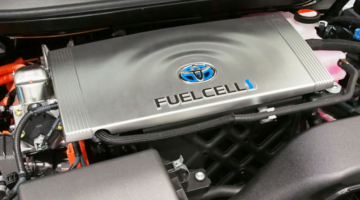
Clearly, as there are no tailpipe emissions, electric cars are better for the environment than other options. However, that does not mean they are completely carbon neutral, as manufacturers might like you to believe.
Electric cars indirectly cause emissions from the following:
Manufacture
Making electric cars uses a lot of energy. Scientific studies have shown that manufacturing an electric vehicle generates more carbon emissions than building a traditional car. They need to be light, which means manufacturing high-performing metals. Factories use vast amounts of energy and often produce huge levels of greenhouse gas emissions.
The Union of Concerned Scientists has calculated that:
Manufacturing a mid-sized EV with an 84-mile range results in about 15 percent more emissions than manufacturing an equivalent gasoline vehicle. For larger, longer-range EVs that travel more than 250 miles per charge, the manufacturing emissions can be as much as 68 percent higher.
Energy source
Electric cars are only as green as the energy you charge them with. As a majority of the UK’s electricity comes from non-renewable sources, your car will have indirectly generated carbon emissions before you even get in it and drive.
Until very recently, the UK has generated a majority of its energy from coal-powered plants. Burning coal has several downsides for the environment. It releases large amounts of carbon dioxide and other harmful gases into the atmosphere; this pollution affects human health as well as contributing to global warming.
This will no longer apply in 2025, when the UK’s coal power plants have all been shut down. However the Government are keen to replace them with fracking or nuclear – neither of which are green alternatives. This means, like it or not, there will be an environmental impact from you using an electric car. While electricity itself is a clean fuel, it is more often than not generated in plants run with fossil fuels.
A potential way around this problem in the future is battery storage. Whilst at the moment, electricity is largely used at the time it is generated, new technology means it can be stored efficiently for the first time. In theory, a household could charge an electric car from a battery fed with electricity generated at home, with solar PV. However, this could be expensive and it may not be possible for households to generate the amount of electricity needed to power their cars.
Battery recycling
Electric cars have huge chemical batteries and research is still ongoing for a low-energy, environmentally friendly way to recycle them.
At the moment, recycling lithium-ion car batteries is long-winded and inefficient. In some cases, a battery is shredded and separated into its components, where some materials such as metal may be able to be reused. Or, if it may still hold some charge, it is frozen in liquid nitrogen and smashed into bits. It is estimated that only 20% of the materials can be reused after these processes.
Although an electric car battery is considered redundant once it only retains 70-80% of its original capacity, many of them function after removal from vehicles and can therefore be converted for use with solar PV systems. This is probably the way forward in terms of the greenest solution, but it is a long way off being adopted on a notable scale.
In conclusion…
While electric vehicles do have some impact on the environment, they are still a great option for reducing your carbon footprint, compared to standard petrol or diesel engines.












You believe that Nuclear Power is not green but battery storage is? I think you need to check your facts.
Nuclear not being green? Like it or not, it still required. Overall very low CO2 and all the waste can be accounted for, and dealt with via geological disposal. Biggest existential threat to mankind is a heating planet. We need to be grown up about the problem and not discard possible solutions to the immediate problem
Because everyone has been told how dangerous nuclear power is they have instead decided to burn al the trees on the planet in biomass generating plants. So construction wood prices are going through the cealing as the world is chipping and burning forests in “renewable biomass plants. Nuclear is safe if you have backup systems (missing at 3 mile Island) You don’t get bored and play with your rod (naughty humor intended lol) Chernobyl or you don’t build it in tsunami coastline areas like Japan did. Nuclear waste can be desposed of in abandoned deep mines 5000 to 10,000 feet deep well below ground water. A great movie to watch is “Planet of the Humans” Director Jeff Gibbs. Nuclear is the very best option for a planet that needs to go electric without burning stuff creating carbon.
Absolutely. Green, not so green after all. And they still haven’t begun recycling ev batteries, large scale. Ride your bike. Walk. Live in the city.
I tend to agree, but living in many northern cities, does not mean living near reliable public transport. Unless of course you live in the city centre, then getting out of the city presents a similar problem.
Amen
The more electric cars on the road the better. It will free up more petrol for my 7.5 litre Lincoln.
Hi Pete,
If you want to hear our opinions on nuclear power, I suggest you take a look here – https://www.youtube.com/watch?v=qdBhlg8oOg0. It’s a bit more comprehensive and recent than the brief mention of nuclear power here!
Thanks,
Harri
ELECTRIC CARS HAVE AIDS
I hate electric cars
True
No U
Nobody wants to notice that fuel cars transform the energy of fuel into mechanical energy directly. With electric cars on the other hand, we have multiple stages.
First, the fuel is burnt at power plants and the energy of fuel is transformed to mechanical energy of turning turbines and electrical generators,
then electrical generators transform this mechanical energy into the energy of electrical current,
then the energy of electrical current is transformed into the chemical energy of the car batteries,
then the chemical energy of the batteries is transformed into the energy of electric current for electric motors,
and eventually electric motors transform the energy of electric current into mechanical energy moving the car.
As the efficiency is always below 100%, there is a loss of energy at every stage of its transformation, especially in the batteries. Therefore, to move an electric car, let’s say for a distance of one mile, you will need to burn about 50% more fuel than it is needed for a petrol car.
For tens of millions of electric cars in the UK we will need to build a few new power stations just for the cars.
2020-03-05
Anonymous, You forget that an ICE engine is less than 17% efficient. At least 83% of the energy goes into making the engine hot. not to mention the power used to cool the engine, (which is not recaptured), to charge the 12-volt battery, to run the vacuum system, etc.
Running an electric car still uses less than 50% of equivalent fuel per mile, after all of what you have considered, since an electric engine is extremely efficient.
As another anonymous person said, the fleet of diesel trucks to deliver the fuel is one thing, but their is also the energy used to remove the petroleum from the ground, transport it to a refinery, and refine it into 87-93 octane petrol, all before it is even trucked to the filling stations.
All this assumes that the mining, manufacturing, and charging will all be using coal-burning power plants. That is not a negative to electric cars; it is a negative to coal-burning power plants. That is why the entire world, (except Trump’s America), is moving away from coal. (Well, the American electric producers are moving away from coal, even with the President attempting to re-open coal mines with tax-payer’s money).
Currently in the UK, Biomass, nuclear, and Wind all contribute more than coal, and the biggest contributor by far, at nearly 50%, is natural gas. So all your FUD is debunked.
Forgetting about China in your rant about US running toward coal. Your rant is not factually …just political.
China uses coal to produce almost 60% of their electric needs. And until, China gets onboard with environmental concerns you might as well just beat your head against the wall.
Its ok to say it costs less per mile to run an electric car over current compatriots .The issue is there will be more pollution than current in extracting the billions of tons of raw material to create a finished the batteries So they may offer a cheaper alternative to run but a massive amount more pollutants to produce and then use and recycle
And your argument is invalid in areas other then UK where energy generation isnt so green (or worse – fluorescent green).
Try watching “Planet of Humans” Michael Moore…Exposes the green movement
Everyone is forgetting that it takes a vast fleet of DIESEL TRUCKS to deliver all that gas to all of the thousands upon thousands of gas stations across the land…Why arent you counting all of that enormous ammount of TRUCK DIESEL EXHAUST !! I have to ask just wHat are you smoking becaUse it must be pretty good ha ha
So build a pipeline, so Joe Biden can cancel it…..
I notice you quote the Union of Concerned Scientists using an out of context excerpt. They are well known to be a group of climate change deniers. You also mention the use of home solar in conjunction with batteries.You don’t need to use batteries. Solar works just fine as a power source. Batteries are being reused after use in vehicles. Nissan use older batteries at their plants to provide power storage from their solar arrays.
Much of the UK now uses Wind power from off-shore and in fact the grid is cleaner than ever.
“They are well known to be a group of climate change deniers”.
I go to their website, and *literally* the very first thing that pops up is a box in the middle of the screen: “The Climate Crisis Is Here, Urge your senators to invest in climate solutions”
Do you just open your mouth and let verbal diahorrhea pour out of it?
I do see positives to electric power yet what’s wrong with hydrogen? Hydrogen is far more efficient to obtain than any other fuel as it is by far the most abundant element in the universe. Refuelling times are only a couple of minutes and the only emmisions are water. Plus, A fuel cell is much more power dense than an EV battery. For efficient motoring and an exciting drive, I vote hydrogen. However I am still a strong petrol head.
I would hate to be in an accident with a hydrogen fueled car. Does Hindenburg ring a bell?
If clobbered petrol vapour is pretty volatile too! The Hindenburg tragedy was in the 1930’s. I think you’ll find that things have moved on in the last 90 years….
Hydrogen is not a green solution either. It takes electricity to break down petroleum, water and to extract free hydrogen from the atmosphere.
“A potential way around this problem in the future is battery storage. Whilst at the moment, electricity is largely used at the time it is generated, new technology means it can be stored efficiently for the first time. In theory, a household could charge an electric car from a battery fed with electricity generated at home, with solar PV” So how would that work if you lived in a multi storey apartment???
How much less fossil fuel is used to power an electric car than a petrol driven one?
Everyone forgets the ammount of TRUCK DIESEL EXHAUST that it takes to transport and deliver all that gas to all those gas stations. Why doesnt this count as part of the “carbonfootprint” of Internal combustion engines?? I guess that everyone is smoking some really good stuff, including Forbes among others ha ha
My concern is the batters this could be worse for the environment in long term
Building an EV does not create more pollution than gas cars. All the parts that go into a gas car come from many different areas and different countries. Than all the drilling for oil and refining and all the cleanup of oil spills. It goes on and on . How about what it is going to take to restore the Canadian tar sands area. By the time that area is restored the only gas guzzlers will be in the museum with steam locomotives. You guys who come up with these lies about EVs must work for big oil
Lmao im here for my science assignment
How does the ecological footprint of an electric car stack up against a hydrogen-powered car?
What if we converted our petrol and diesel vehicles to run on hemp oil would that be better for the environment
Or Bio fuel cars , that are carbon positive .
Quote from the article:-
“While electricity itself is a clean fuel, it is more often than not generated in plants run with fossil fuels.”
As it stands now and for the foreseeable short term all electrci cars in the U.K. charged from the grid are supplied by fossil fuel generated electricity, While that may erronous, two fcators give this fact. One is that electric cars are an extra demand on the grid, the second is that any extra demand is met by dispatchable power. Dispatchable power is a source of genertaion that can react to load demand and are the generators that balance the grid’s supply and demand. Nuclear and renewables are not able to do this and, operationally, run at maximum available output at all times, menaing that they have no more to give for an extra demand.
I believe the government is not really aware of how the grid actually works and that their idea of using electricity to reduce CO2(As they are also doing in trying to make heat pumps the heating source of the future, the same applies to them)
As grid demand grows so will CO2 emmissions. Yes they are adding more wind but older farms are coming to the end of their life and given that the figures government publish are no where near what the actual output of wind farms is, I expect demand to exceed current wind output as time passes.
This is exactly what producing electric cars does. It’s the same with solar panels as well. But the more CO2 is released, the more people will want to buy “green” things such as electric cars
What if we converted our petrol and diesel vehicles to run on hemp oil would that be better for the environment
Can we take a step back and understand this is a huge money making exercise by the car manufacturers. Once we have all been duped into buying an electric car they will bring out the cleaner more environmentally sound hydrogen fuel cell powered cars. so we all have to buy a overly expensive car twice! Its like most technology these days, as soon as we all have it it becomes redundant so we are told we need to buy ‘the newest thing’ and like the blind sheep we are we do, money for the big boys!
Remember its not about the environment its about MONEY!
Can we take a step back and understand this is a huge money making exercise by the car manufacturers. Once we have all been duped into buying an electric car they will bring out the cleaner more environmentally sound hydrogen fuel cell powered cars. so we all have to buy a overly expensive car twice! Its like most technology these days, as soon as we all have it it becomes redundant so we are told we need to buy ‘the newest thing’ and like the blind sheep we are we do, money for the big boys!
Remember its not about the environment its about MONEY!
Can you please provide a comparison of the carbon footprint of a new EV electric vehicle versus the conversion of a petrol/diesel vehicle to electric
In the UK, banning the sale of diesel and petrol cars and moving to EV’s only will have a massive impact on air quality the environment maybe less so. But most of it will be because the vast majority of people will no longer have access to private motoring, on the plus side the mechanics needed to keep older vehicles in use should create some more jobs.
Cuba comes to mind.
The fixation of NEW is the problem. The car industry can’t make money unless we’re buying their latest offerings. The CO2 lag in purchasing a new EV is significant. Better to buy a second hand car and extend it’s life. Of course air quality is important, but climate change is the deal breaker. We have to stop consuming
The answer is hydrogen ,the real way to go … you will notice that Johnson and the likes will have shares in the wind farms thus push the electric cars for their own gains whatever the cost to the environment
But how can anyone say that there will be .essentially less pollutants produced. There will be a massive impact on certain countries to produce the required resources needed per battery and the pollution to extract the raw materials and then to convert them to a usable form and the disposal of them after their shelf life is over to recycle to make more is and would be greater than now,This is also the case for the manufacture of the vehicles which produces more toxic pollutants than a petrol or diesel.
It’d be nice if the article included all the sources, otherwise, some of the information sounds not accurate.
agreed, 100%
When was this article first published?
The conclusion is superficial (abstract, no facts) and “keep your fingers crossed’. The premise is totally flawed.
nuclear produces no carbon emissions nor does its long term spent fuel storage so it is considered to be a Green source on that basis. The principle of battery power as a chemical reaction has changed little since its 19th century invention and had any huge breakthrough been possible it would have taken place already. Battery vehicles are therefore a dead-end. Commercial heavy equipment cannot run on battery due to the limited useage/recharge time, vastly increased weight and cost.
Nuclear energy has a carbon footprint. It must be mined and processed into a useable form.
What worries me is what happens to the lithium vehicle batteries after their 8 years of useful life. I understand that in the foreseeable future there is no possibility of fully recycling them, we must expect the number of these large batteries to be scrapped every year to be more than 0.2 BILLION worldwide. Most countries will allow the batteries just to be dumped as with plastic bags, but plastic bags don’t, as they decay, leach the extremely poisonous lithium and cobalt in to the ground water and sea killing everything. Nuclear waste is in small quantities but after thousands of years is safe, lithium and cobalt lasts for ever.
If a safe battery was invented that had the same characteristics as the lithium battery, it would be great, but other than hydro, flywheel and thermal the only safe energy storage method is hydrogen which the government is working on , but not fast enough.
At present wind turbines are at a standstill a lot of the time as the base load generation can’t be stopped. This waste should be used to produce hydrogen by putting both ends of the cables into the sea via an electrolysis plant. Hydrogen naturally will come off one end of the cable and be pumped into defunct oil / gas wells for storage. When needed, the hydrogen would come ashore to be used for everything oil and gas are used for now. Petrol cars can be converted to hydrogen. Oxygen naturally will come off the other end and if the electrolysis plants are on the sea floor, the oxygen then would bubble through the sea oxygenating the water expanding the fish stocks. The oxygen would reduce the concentration of CO2 in the air reducing global warming. Any impurities in the gases could be removed using catalysts. Hydrogen can be easily stored and can power anything presently powered by oil or gas, with modification including base load electric. As the reduction in energy requirements continues i.e. LED lighting and insulation in buildings (the government appears not interested in this) and as wave power is yet to be exploited, we may be able to produce all our energy from hydrogen without any pollution whatsoever.
no date on this article …. very important in a fast moving field.
Why not push for more hybrid vehicles, which are less expensive for the general public? A non plug in hybrid where the gasoline engine recharges the battery’s life and reduces the amount of fuel required to power the car? The use of nuclear energy is carbon intensive, mining the uranium and then having to deal with spent fuel rods that cannot be recycled and will remain radioactive for many thousands of years.
Poor story. If long range vehicles use around 70% more energy to manufacture why not tell us how long it takes to pay this back. Also the payback on the recylclong of the batteries. This would provide an honest story. Also if you sold 1 billion electric cars in one year how would this effect the environment. And what would you do with 1 billion petrol cars. Way to simple story. Lazy writting. Ps i have a hybrib car.
Can this statement be referenced from a credible source?? ‘Manufacturing a mid-sized EV with an 84-mile range results in about 15 percent more emissions than manufacturing an equivalent gasoline vehicle. For larger, longer-range EVs that travel more than 250 miles per charge, the manufacturing emissions can be as much as 68 percent higher.’
If all vehicles become electric (cars, lorries, buses), how much total electrical energy is going to be needed to charge them? Where is this massive amount to come from, especially at night with no wind? Also, the transmission/distribution system will need huge reinforcement. Has this calculation been done yet?
What is the publication date of this note? What scientific research? “At the moment, recycling lithium-ion car batteries is long-winded and inefficient” Impossible to know what “moment” is that. No citations, no dates, therefore, no credibility.
Dont understand thet you confider co2 to be a harmful gas.
Current levels are restricting plant growth and the worlds population cant be sustained in food with levels at 1000 BC ref
Atmospheric physicists eg
Professors w.Happer,R Linzen
Suggest you look back ar geological co2 levels
Tell our food crops etc that co2 is a harmful gas.
Complete nonesense, only life cycle comparisons can show true carbon footprint. The manufacturing carbon footprint for even a small BEV such as the Nissan Leaf is double that of an ICEV. For a typical part green European energy mix the break even is around 40,000km. For a an energy mix with a high coal input the break even is around 140,000km. (source MDPI Research project) There are 1.3 billion passneger vehicles on the roads and we build around 85 million vehixles a year. If you start now replaciong all ICEV’s, it will take some 15 years. Battery life 8-10 years so start again in 8-10 years with most polluting part of the BEV. This means forwever a doubling of carbon emissions! Not that any of this matters anyway since as the new head of the IPCC stated in a German interview, “There is no climate crisis” as confirmed by the IPCC group one report. We are in anatural warming phase and arebeginning to leave the current El Nino warm period leading toa cooler phase which will mean the oceans will absorb more carbon. Soon the paid climate zealots will be shown conclusively that their predictions are bullshit and are costing the world economy billions which we the public are paying for. MartynL